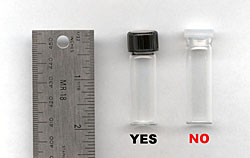Preparing your sample for submission
The sample should usually be solvent-free and pure. (Purity is not a requirement for GC/MS or LC/MS, and both ESI and MALDI can also handle moderate mixtures.) There should be no excess salts in your sample, especially for FAB, ESI, and MALDI. Buffers such as phosphate and HEPES are fatal to these techniques. Weigh out your sample into a small screw-top vial. For very small amounts of sample, a Reacti-Vial is best. This is especially true for oils. Oil smeared around the inside of a regular vial is very difficult to get out. For high molecular weight biomolecules, such as peptides, an Eppendorf-like tube is required. Use an inert cap liner, such as aluminum foil or Teflon, for screw-top vials since we may use a solvent which will leach plasticizers out of the caps. Solvent is always used for FD, FAB, ESI, MALDI, GC/MS, and LC/MS. Accurate weighing is mandatory for FD, ESI, MALDI, FAB, GC/MS, and LC/MS and is important for other techniques. The amounts required vary by ionization technique and instrument. As a quick rule of thumb, 1 mg is always enough. ESI and MALDI require very small amounts of sample. For specific amounts, see the ionization techniques section.
The reason we want pure samples for most techniques is that impure samples do not give good mass spectra. The mass spectrum of a mixture is a confusing jumble of molecular ions and fragments from each component. Also, the signal for any one component will be weaker than if it were pure. To make matters worse, the spectra of some components may be totally suppressed by the others.
Radioactive Sample Permissible Levels: The maximum permissible levels of radioactivity for samples submitted for normal MS analysis is 86 microcurie for 3H and 43 microcurie for 14C. This corresponds to 0.03% incorporation of tritium and 7% incorporation of carbon-14 in a 2 mg sample.